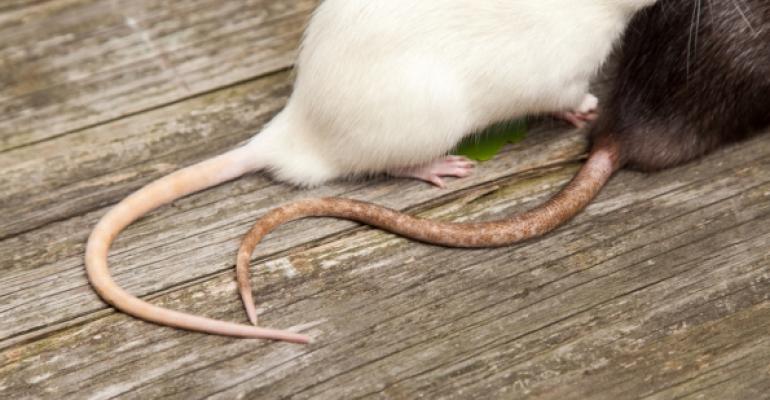When the temperature drops, rats and mice are on the move, looking for warm shelter inside. Storms and floods can also send them in search of dry spaces.
“You will get some migration from mice in the fall,” says Marc Buck, a branch manager for Western Pest Services, which is based in Parsippany, New Jersey. “They will start to move inward if temperatures drop and food options diminish.” Migration can also occur in the summer during droughts and extreme hot weather.
“Rodents prefer to be in the same environments we prefer,” says Buck, who has 30 years of pest control experience.
In addition to weather, construction and redevelopment can unearth rodents and start a migration. Rats, in particular, are quite capable of moving great distances quickly, traveling half of a mile or three-quarters of a mile with ease.
“Rodents are looking for food and shelter, so restaurants are under a constant threat,” Buck says.
Rats and mice are known to carry diseases such as Salmonella and trichinosis. They leave behind droppings, chew through food containers and other items and contaminate and destroy food supplies. They can multiply quickly if left unchecked. And the sight of a rodent scurrying across a table or hanging from a curtain in the dining room, at a time when almost everyone has a cell phone camera and immediate access to social media, could destroy a restaurant’s reputation, Buck says.
“The best practice is to stop a problem before it becomes one,” he states.
Restaurant operators committed to zero tolerance of furry vermin year-round need to look beyond the four walls of their establishment to prevent infestations. Once pests are inside, options are limited to non-toxic traps. The better strategy is to keep them from invading in the first place, Buck says. The first line of defense focuses on the exterior.
Defending the Perimeter
Pests are attracted by food odors. One of the most important areas to monitor is the dumpsters and trash bin corrals. Trash should be picked up regularly and lids kept closed.
“Deodorize those areas and make sure they are being inspected,” Buck says.
In addition, a safe distance should be maintained between restaurant entrances and dumpsters. Local ordinances may allow them to be closer than desired, but keeping areas as clean as possible will help, as will maintaining regular pest control inspections.
Plants and shrubbery also must be maintained around the building, says Buck. High grass and weeds will harbor mice and rats.
“The first line of defense is a good exterior program,” he says, noting that pest technicians should inspect the building’s exterior, trash corrals and vegetation.
Defending Entrances
The structural integrity of a facility is also critical to preventing rodents’ access to a restaurant.
“Mice, especially, are opportunists,” Buck says. “They run along a wall line and the first opening that exists, they will investigate. Nine times out of 10 the opening allows them to enter the structure.”
Mice can squeeze through an opening as small as a quarter of an inch, while rats can make it through a half-inch opening. Most rats, however, can be managed on the exterior. They are less likely to gain entry than mice are, Buck says.
Points of entry for rodents can also be areas where underground utilities connect with buildings — phone lines, power lines, plumbing, etc. Holes and cracks should be sealed.
Door sweeps should be well attached and functional. Despite the temptation, doors should not be propped open during deliveries, nor should employees leave doors cracked open while they are outside on a break.
“The idea of a clean facility that cannot incur a problem is absolutely false,” Buck says. “We’ve seen sterile situations such as hospitals with rodent issues. The problem was structural issues that allowed entry.”
United Defense
Operators need to work with their pest control technicians, Buck says. Professional technicians are trained to know what to look for, such as droppings or grease rubs — oily marks rodents leave behind when they run over the same area. Technicians can detect odors associated with mice and rats, such as the smell of their urine. Damaged containers and products are other signs of infestation.
Technicians usually work after restaurant hours, so often when they are on the premises, managers, owners or decision-makers are not in the restaurant. That can lead to a breakdown in communication, Buck says.
“The challenge during those after hours is the technicians are not interacting with the right people, the decision-makers” he says.
Operators should schedule meetings with technicians to discuss areas of concern. “Pest control is a partnership on both ends,” Buck says. “The program will never be a success without it. Partnership is number one.”





